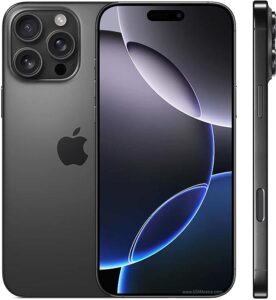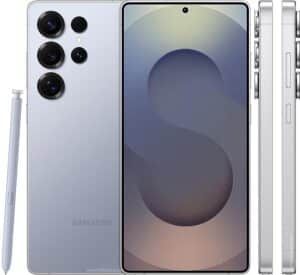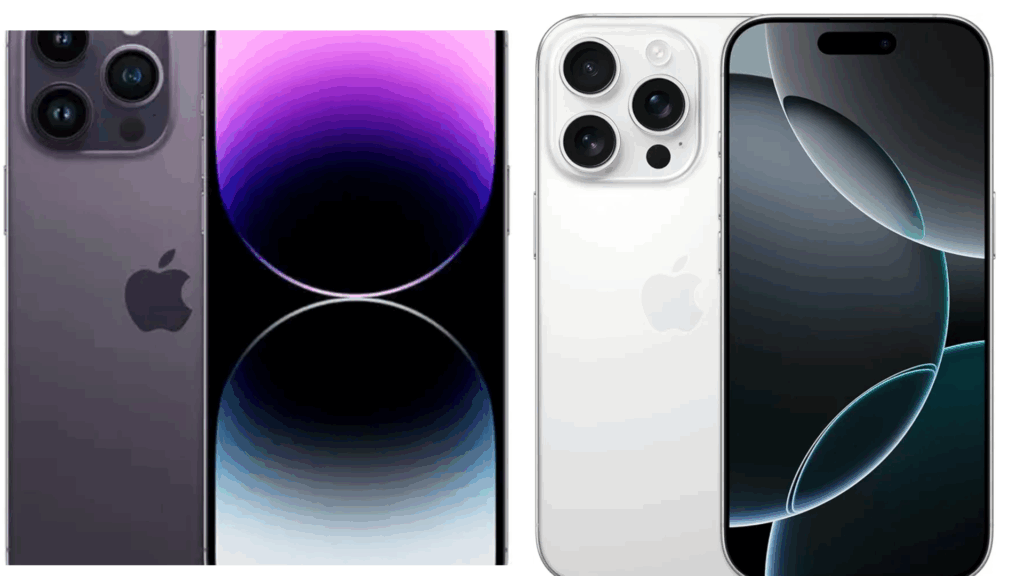This is a comparison of two latest and powerful smartphones in 2025. The battle between two latest phones, the iPhone and the Samsung phone. In this post I will be doing justice to which is truly the G.O.A.T (greatest of all time) in 2025 of the Samsung Galaxy S25 Ultra and Apple’s iPhone 16 Pro Max. When we take these two phone side by side you will really attest to it that they aren’t just flagship phones. They phones represent the very best each brand can offer in terms of innovation, performance, design, and user experience.
For buyers looking to upgrade their choice or sitting on the fence to choose between these two phones maybe to use and experience it for the next 2–3 years. Are you ready to go with the Samsung’s powerhouse loaded with features and customization, or you want to stick with Apple’s seamless ecosystem and polished user experience?
This blog post aims at comparing the samsung galaxy s25 ultra vs iphone 16 pro max


Quick Specs Overview: Key Differences at a Glance
Before we take this phones side-by-side, here’s a quick specification to give you a quick overview of how both phones stacked up against each other:
| Feature | Samsung Galaxy S25 Ultra | iPhone 16 Pro Max |
|---|---|---|
| Display | 6.8″ QHD+ AMOLED, 144Hz, 3000 nits | 6.7″ LTPO OLED, 120Hz, 2500 nits |
| Processor | Snapdragon 8 Gen 4 (3nm) | Apple A18 Pro (3nm) |
| RAM | 12GB / 16GB | 8GB |
| Storage | 256GB – 1TB (UFS 4.0) | 256GB – 1TB (NVMe) |
| Rear Cameras | 200MP main + ultra-wide + telephoto + periscope | 48MP main + ultra-wide + 5x telephoto |
| Battery | 5,500mAh, 65W wired, 25W wireless | 4,800mAh, 35W wired, 15W MagSafe |
| Software | One UI 7 (Android 15) | iOS 18 |
| Extras | Built-in S Pen, DeX Mode | Dynamic Island, satellite emergency SOS |
The illustrations above show how different these two phones are in philosophy Samsung ther gives you flexibility and raw specifications in there product, while on the other hand Apple leans into efficiency, stability, and ecosystem perks.
Design & Build Quality: Form Meets Function
Samsung Galaxy S25 Ultra Design
Let first start from the basics the Samsung s25 keeps its signature Ultra design alive in 2025, with a sleek, boxy silhouette. But there are refinements slimmer bezels, slightly curved edges for better grip, and a more seamless integration of the camera array. The back uses matte Gorilla Armor Glass 2, which resists smudges and scratches better than previous versions.
The titanium frame gives the phone a more luxurious hand feel while also reducing the overall weight compared to the S24 Ultra. The built-in S Pen is still housed in the bottom-left corner, and this year, it feels more responsive with lower latency and better handwriting-to-text accuracy.
iPhone 16 Pro Max Design
Apple doesn’t rock the boat with its design either. It continues with the squared-edge, premium titanium frame introduced in the iPhone 15 series. The back glass is more refined this time, with a soft matte finish that feels silky but still offers grip.
The Dynamic Island remains a staple feature—less of a design choice and more of a software-hardware fusion that Apple has integrated into system notifications, Live Activities, and apps. While some people still find it gimmicky, it’s more useful now than ever.
Durability & Ergonomics
Samsung is more ergonomic thanks to curved edges, even though it’s physically larger.
Apple still feels heavier and boxier, but durable. Both phones are IP68-rated.
Samsung’s use of Gorilla Armor 2 provides better drop and scratch protection.
Apple’s Ceramic Shield protects the front and back, but drop tests still favor Samsung.
Verdict: Samsung wins on ergonomics and scratch resistance. Apple wins on fit and finish polish.
Display Technology: Visual Experience in 2025
Samsung Galaxy S25 Ultra Display
Samsung’s 6.8″ QHD+ Dynamic AMOLED 2X panel is simply breathtaking. It pushes brightness up to 3,000 nits, making it the brightest display on a smartphone to date. That means content is perfectly visible—even under direct sunlight.
What’s new in 2025 is the jump to a 144Hz adaptive refresh rate, making animations, scrolling, and gaming feel ultra-smooth. Watching HDR content? You’ll love the contrast, color depth, and overall immersion.
Samsung also refined its touch sampling rate, making stylus input and gaming far more responsive. Paired with Vision Booster 2.0, this is easily the best display ever on a Galaxy.
iPhone 16 Pro Max Display
Apple’s 6.7″ Super Retina XDR (LTPO OLED) display isn’t far behind. It peaks at 2,500 nits brightness and remains stunningly accurate with Dolby Vision support. The 120Hz ProMotion refresh rate dynamically adapts to your activity, helping with both fluidity and battery efficiency.
Color calibration is where Apple excels—true-to-life tones, balanced whites, and deep blacks. iPhone displays always lean toward realism, while Samsung’s offer more vibrant, saturated visuals.
Always-On & Extras
Samsung: Customizable always-on screen with widgets and colors.
Apple: Minimal always-on (date, time, notifications) with blurred background.
Verdict: If you want the most immersive, customizable, and future-ready display, Samsung wins. If you prefer color accuracy and system integration, Apple holds its ground.
Performance & Processing Power
Both phones use the most advanced 3nm chips of 2025. Here’s how they stack up in raw power and day-to-day performance:
Samsung Galaxy S25 Ultra
Powered by the Snapdragon 8 Gen 4, Samsung’s performance leap this year is serious. This chip delivers better multi-core performance, GPU rendering, and AI efficiency compared to Gen 3.
Apps launch instantly, multitasking is fluid thanks to up to 16GB of RAM, and high-end games like Genshin Impact or Call of Duty Mobile run at 60fps without drops. Samsung also improved thermals—less heat under load and better battery optimization during intense tasks.
iPhone 16 Pro Max
Apple’s A18 Pro chip continues to lead in single-core performance. It’s brutally efficient and tightly integrated with iOS 18. The result? The phone feels instant—animations, app switching, and system-wide actions are buttery smooth.
Gaming performance is great too, but the iPhone does warm up faster than the Galaxy when pushed. That said, iOS handles background app management better, which keeps RAM usage lower without slowing things down.
Benchmark Snapshot:
| Test | Galaxy S25 Ultra | iPhone 16 Pro Max |
|---|---|---|
| Geekbench Multi-core | 7,400+ | 6,800+ |
| Geekbench Single-core | 2,100 | 2,500 |
| GFXBench (Manhattan) | 165fps | 145fps |
Verdict: Samsung wins for multitasking, GPU, and thermals. Apple takes the edge in energy efficiency and UI responsiveness.
Camera Systems: Creativity Meets Power
This is where both phones bring serious upgrades in 2025.
Galaxy S25 Ultra Camera Setup
Main: 200MP f/1.7 sensor with adaptive pixel binning
Ultra-wide: 12MP, 120-degree field
Telephoto: 50MP 3x
Periscope: 50MP 5x with 100x digital zoom
The 200MP main sensor captures amazing detail, especially in daylight. Low-light shots are sharper this year thanks to improved night processing and a new AI Image Engine that enhances contrast and reduces noise intelligently.
Samsung also adds AI-powered portrait video, Slo-Mo in 4K120, and full manual RAW control for pros. Zoom levels are clearer, with minimal degradation up to 30x.
iPhone 16 Pro Max Camera Setup
Main: 48MP f/1.8 sensor (2nd gen)
Ultra-wide: 12MP with macro
Telephoto: 12MP 5x periscope (new for 2025)
Apple’s strength is computational photography. Shots are instantly balanced, faces look natural, and Smart HDR 6.0 makes every frame look editorial. The new periscope lens brings it closer to Samsung in zoom, though digital zoom maxes out at 25x.
Cinematic Mode now supports 4K60, and Apple added spatial video capture for Vision Pro compatibility.
Verdict: Samsung leads in hardware versatility and zoom. Apple leads in realism, video quality, and consistency.
Software & Ecosystem: Android Freedom vs iOS Cohesion
Samsung Galaxy S25 Ultra: A Power User’s Playground
The S25 Ultra runs One UI 7, built on Android 15, and it’s arguably the most powerful and customizable mobile software environment available today. From the moment you power it on, you’re greeted with a UI that you can completely make your own. Everything is adjustable—icons, widgets, notification panels, even how apps behave when they’re in the background.
But what really sets this software apart is Galaxy AI, Samsung’s AI suite that brings some serious smarts:
Live call translation: Talk in one language, and the other party hears it in theirs—real-time.
AI photo editing: Fill in missing parts of an image, erase background distractions, or enhance sharpness—all offline.
Note Assist: Summarizes notes, generates bullet points, and even writes titles based on your content.
Samsung also steps up with Samsung DeX. It’s not just a gimmick anymore—you can plug the S25 Ultra into a monitor or use it wirelessly with a smart TV, and instantly get a desktop experience. It’s fluid enough to use for presentations, documents, or even light video editing.
You also have access to:
File transfers via USB-C (super fast with UFS 4.0)
Side-loading apps (yes, you can install anything—not just what’s on Google Play)
Advanced split-screen and pop-up window multitasking
Samsung matches Apple in long-term support too, promising 7 years of major OS and security updates.
iPhone 16 Pro Max: Seamless, Secure, and Smarter
iOS 18 continues Apple’s tradition of making everything just work. But this time, it goes further with Apple Intelligence—Apple’s all-new on-device AI that’s privacy-first and integrated deep into iOS.
With it, you get:
Context-aware Siri that understands your requests across apps
AI-written email drafts, summaries, and suggestions
Image editing that mimics Photoshop, but is baked right into the Photos app
Where iOS truly shines, though, is the ecosystem. If you own a MacBook, Apple Watch, or iPad, the synergy is unmatched:
Start an email on your iPhone, finish on your Mac instantly.
Use AirDrop to share photos or videos with zero friction.
Universal Clipboard lets you copy on one Apple device and paste on another.
iCloud Keychain and Face ID autofill make logins seamless and secure.
However, customization is limited. You can’t side-load apps, and the UI still has that rigid Apple feel. But it’s stable, polished, and generally bug-free.
Bottom Line:
Go with Samsung if you want complete control, multitasking power, and desktop-level productivity on a phone.
Go with Apple if you’re deep in the Apple ecosystem or want a smooth, smart, and secure experience.
Battery Life & Charging Speed: Who Lasts Longer and Charges Faster?
Battery life is one of the biggest daily pain points for users—and Samsung and Apple take very different approaches here.
Samsung Galaxy S25 Ultra: Bigger Battery, Blazing Speeds
Battery Capacity: 5,500mAh
Wired Charging: 65W (USB-C PD)
Wireless Charging: 25W
Reverse Wireless Charging: 10W
Samsung went big this year—literally. With a 5,500mAh battery, power efficiency from the Snapdragon 8 Gen 4, and smart refresh rate scaling from 144Hz down to 1Hz, the S25 Ultra comfortably lasts a day and a half with moderate-to-heavy use.
Even better? Charging is lightning fast:
65W wired charging takes the phone from 0% to 100% in under 40 minutes.
Wireless charging is competitive too, especially if you’re using a Samsung-approved pad.
And if your earbuds or a friend’s phone is dying, reverse wireless charging lets you share power instantly.
iPhone 16 Pro Max: Efficiency Over Raw Power
Battery Capacity: 4,800mAh
Wired Charging: 35W
MagSafe Wireless: 15W
Reverse Charging: Not supported
Apple doesn’t play the specs game. Instead of cranking up the battery size, the iPhone 16 Pro Max relies on iOS-level software efficiency. It gets you through a full day on a single charge, and even better on standby. But if you’re gaming, watching 4K video, or editing ProRes footage, it drains fast.
Charging is slower by 2025 standards:
Wired charging maxes out at 35W and takes around an hour to fully charge.
MagSafe wireless charging is still capped at 15W.
Bottom Line:
If fast charging and long battery life are priorities, the S25 Ultra crushes it.
The iPhone holds its own, but charging speeds and battery size haven’t evolved much.
Storage Options & Price: Which Offers More for the Money?
Samsung Galaxy S25 Ultra: Speed, Capacity, and RAM to Match
Storage: 256GB, 512GB, 1TB (UFS 4.0)
RAM: 12GB or 16GB
Price Range: $1,199 – $1,599
Samsung delivers flagship performance across the board. Whether you’re editing 8K videos, gaming with ray tracing, or using Samsung DeX, the extra RAM (up to 16GB) makes a difference. UFS 4.0 storage is blazingly fast, reducing app launch times and data transfer delays.
iPhone 16 Pro Max: Speedy but Static
Storage: 256GB, 512GB, 1TB (NVMe SSD)
RAM: 8GB (fixed)
Price Range: $1,199 – $1,599
Apple’s NVMe SSDs are super fast, especially in creative workflows. If you use Final Cut Pro Mobile or record ProRAW or ProRes footage, the speed is noticeable. But Apple still caps the RAM at 8GB—enough for everyday use, but a bit tight for multitasking-heavy pros.
Bottom Line:
Samsung offers better value for power users, especially those who need more RAM.
Apple keeps things simple—but it may feel limiting for pros expecting laptop-grade multitasking.
Special Features: What Makes Each Phone Stand Out?
Samsung Galaxy S25 Ultra’s Unique Tricks
S Pen: Not just a stylus—it’s your precision tool for sketching, photo editing, and navigating without touching the screen.
Samsung DeX: True desktop experience on a monitor or smart TV.
AI Tools: Translate live conversations, generate presentations, and auto-enhance images.
Space Zoom: Up to 100x with optical and AI enhancements.
Power User Extras: Game Booster, battery profiles, theme engines, and rooting potential.
iPhone 16 Pro Max’s Premium Perks
Apple Intelligence: Contextual Siri, AI photo editing, natural language search across messages and files.
Dynamic Island 2.0: Now supports live activities from third-party apps.
Spatial Video Recording: Shoot immersive video that can be viewed in full 3D on the Apple Vision Pro.
Satellite SOS + Check-In: Still the industry leader for safety features.
Deep Ecosystem Sync: AirTags, AirPlay, Handoff, and FaceTime handoff across Apple gear.
Bottom Line:
Samsung gives you a toolbox.
Apple gives you a luxury suite of seamless, secure features.
Real-Life Experience: What It’s Like to Use These Phones Daily
Galaxy S25 Ultra: Built for Power and Productivity
Using the S25 Ultra feels like carrying a high-end workstation in your pocket:
The 6.8-inch QHD+ AMOLED display is buttery smooth and ultra-bright, perfect for media and multitasking.
The S Pen makes a real difference when taking notes, signing documents, or editing photos.
The phone handles anything you throw at it—intensive gaming, 8K editing, or full DeX mode—with zero slowdowns.
But it’s big. If you prefer compact phones, this may feel bulky.
iPhone 16 Pro Max: Consistency, Class, and Cohesion
The iPhone feels like a refined, luxury device:
The UI is polished and consistent across every app.
Apple’s haptic feedback, camera shutter sounds, and animations make using it feel satisfying.
Little things—like unlocking your Mac with Face ID on your phone, or answering texts from your watch—make your tech life simpler.
Downside? It doesn’t give you as much control. Power users might find it restrictive.
Bottom Line:
The S25 Ultra is for creators, techies, and pros.
The iPhone is for those who want beauty, polish, and tight-knit tech without fuss.
Which One Is Right for You?
Why the Galaxy S25 Ultra Might Be the Smarter Choice for Power Users
If you’re the kind of user who wants total control, premium features, and the best hardware Samsung has ever put in a phone, the Galaxy S25 Ultra is built for you.
This phone isn’t just about flashy specs — it’s about real-world productivity. The built-in S Pen transforms the way you work, letting you:
Take notes instantly, even when the screen is off
Mark up screenshots, PDFs, and web pages
Sketch, draw, or sign documents with pinpoint accuracy
The Snapdragon 8 Gen 4 chip (or Exynos 2500 in some regions) pushes performance to desktop levels. You can edit 8K videos, game at high frame rates, or multitask with multiple apps in split screen — without lag.
Samsung’s Galaxy AI tools enhance everything from call translation to photo editing. Want to erase someone from a photo? Just circle them. Want to summarize a webpage? It does that, too.
And for power users, DeX mode turns your phone into a desktop computer — connect it to a monitor, add a keyboard and mouse, and boom, you’re working on a full screen.
You also get:
100x Space Zoom and 200MP photos
65W wired fast charging (almost full in 30 mins)
Customizable interface (change icons, themes, gestures, etc.)
Reverse wireless charging — juice up your earbuds or friend’s phone
In short, if you’re the kind of person who wants your phone to be your main computer, camera rig, and creative studio, the Galaxy S25 Ultra has no rival.
Why the iPhone 16 Pro Max Still Wins for Ecosystem and Simplicity
The iPhone 16 Pro Max is Apple’s best — and most intelligent — phone ever. But more importantly, it’s the most seamless smartphone experience you can get in 2025.
Let’s start with the basics: it just works. Everything from Airdrop to Handoff to iMessage and FaceTime is tightly integrated across devices. If you have a MacBook, iPad, AirPods, or Apple Watch, the iPhone 16 Pro Max slots in perfectly.
But it’s not just about convenience — Apple also nails performance and longevity:
The A18 Pro chip is a beast, and built for AI acceleration with Apple Intelligence
You get 7+ years of software updates, possibly more than any Android phone
The Titanium body makes it lighter and more durable than before
For creators, Apple pulls ahead in one key area: video quality. You can shoot in ProRes, edit in Final Cut Mobile, and even export to your Mac — all lossless, all within seconds. Spatial video capture now lets you create immersive 3D content for Vision Pro, too.
Apple Intelligence is where things get really smart — and private:
Ask Siri to summarize messages or emails
Auto-generate images and emojis
Smart recaps, suggestions, and personalized context… all on-device
And Apple’s privacy stance is clear: AI data never leaves your device unless you choose to use the cloud.
This is the phone for people who want a no-hassle, super polished, and deeply private experience that just gets out of your way.
Final Verdict: Which Flagship Should You Buy?
It’s not about which phone is objectively better — it’s about which phone is better for you.
| Feature | Galaxy S25 Ultra | iPhone 16 Pro Max |
|---|---|---|
| Stylus (S Pen) | ✅ Yes, built-in | ❌ Not supported |
| Camera Zoom | ✅ 100x periscope | ❌ 5x max zoom |
| AI Features | ✅ Galaxy AI (built-in tools) | ✅ Apple Intelligence (on-device + iCloud) |
| OS Updates | ✅ 7 years (new for Samsung) | ✅ 7+ years (Apple standard) |
| Fast Charging | ✅ 65W wired + 45W wireless | ❌ 35W wired, slower wireless |
| UI Customization | ✅ Deep and flexible | ❌ Limited |
| Desktop Mode | ✅ Samsung DeX | ❌ Not available |
| Ecosystem Integration | ✅ With Windows & Galaxy Buds | ✅✅ Best with Apple products |
Here’s the bottom line:
If you want raw power, more features, better zoom, and productivity tools, go for the Galaxy S25 Ultra.
If you want a phone that’s effortless, private, and fits into the Apple lifestyle, the iPhone 16 Pro Max is for you.
You honestly can’t go wrong — it just depends on what kind of user you are.
FAQs: Your Burning Questions Answered
Can I charge other devices with the Galaxy S25 Ultra?
Yes. It supports reverse wireless charging — just place your Galaxy Buds, smartwatch, or a friend’s phone on the back and it’ll charge.
Does the iPhone 16 Pro Max finally have USB-C?
Yes! Apple ditched the Lightning port. But while it uses USB-C, transfer speeds are still slower than what Samsung offers.
Which phone is better for vlogging or YouTube?
If you need social media optimization and tight app control, iPhone wins. But for manual settings and S Pen editing, the Galaxy is more flexible.
What about long-term updates?
Both phones now support 7 years of updates, meaning you’re covered into the 2030s with either choice.
Which one holds resale value longer?
Apple devices tend to hold value better in the secondhand market, but Samsung often gives better trade-in deals during upgrade cycles.
- Top 5 Greater Goods Food Scale For Kitchen Scales 2025: Precision You Can Trust - October 25, 2025
- Top Bluetooth Food Scales 2025 | Precision & Sync Power - October 25, 2025
- Best French Press Travel Mug 2025 | Top Portable Coffee Press - October 24, 2025


